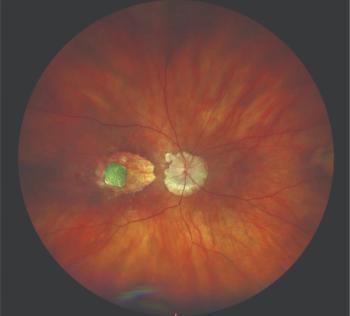
Management of drug-induced cicatricial conjunctivitis and dry eye
A 65-year-old male with a history of congenital cataracts, bilateral cataract extraction and secondary placement of anterior chamber intraocular lenses with subsequent development of glaucoma, cicatricial conjunctivitis, dry eye and limbal stem cell deficiency presented with left eye pain and decreased vision.
History
A 65-year-old male with long-standing ocular surface disease presents for evaluation of decreased vision and pain of the left eye for one week. The patient has an extensive ocular history, including congenital cataracts, bilateral cataract extraction and later secondary placement of anterior chamber intraocular lenses, then subsequent development of bilateral glaucoma and cicatricial conjunctivitis resulting in bilateral limbal stem cell deficiency (LSCD), recurrent epithelial defects, dry eye disease, fornix foreshortening, trichiasis, and entropion. His glaucoma has been managed at an outside facility with maximum topical medical therapy for many years. His bilateral upper eyelid entropion was repaired with oral mucous membrane graft approximately one year prior to presentation. He wears bandage contact lenses and has been using moxifloxicin hydrochloride ophthalmic solution 0.5% (Vigamox®, Alcon, Fort Worth, TX) twice a day and loteprednol etabonate ophthalmic suspension 0.5% (Lotemax®, Bausch+Lomb, Bridgewater, NJ) four times a day in both eyes for at least two years for his severe ocular surface disease. Most recently, he has had to switch from moxifloxicin to polymyxin B sulfate trimethoprim due to a change in his insurance coverage. He was seen by his outside ophthalmologist and referred to the emergency department given concern for severe dry eye disease complicated by a corneal ulcer in the left eye.
Examination
On initial evaluation, the patient had a best-corrected visual acuity of 20/70 with pinhole vision of 20/60 in the right eye, and counting fingers in the left eye. Intraocular pressures (IOP) were 14 bilaterally. External examination showed extensive chronic inflammatory changes of the eyelids bilaterally, including severe induration, thickening, and notching of the eyelid margins, meibomian gland dysfunction and trichiasis. He had diffuse conjunctival injection, greater in the left eye, with forniceal foreshortening in both eyes. The cornea in the right eye had neovascularization 3-mm onto the cornea superiorly, diffuse faint subepithelial haze, and a whorling pattern of the epithelium with scattered punctate epithelial defects. The cornea in the left eye showed a central epithelial defect with associated infiltrate consistent with a corneal ulcer as well as superior fibrovascular pannus 3-mm onto the cornea and band keratopathy temporally. The anterior chamber in the left eye had a hypopyon and there were bilateral anterior chamber intraocular lenses. There was a poor view to the posterior pole in both eyes due to the severe ocular surface disease, but B-scan ultrasound was normal bilaterally.
Discussion and diagnosis
Given the patient’s history of recurrent and non-healing epithelial defects from LSCD, he was at higher risk of developing a corneal ulcer. His long-term contact lens use with chronic administration of loteprednol etabonate ophthalmic suspension 0.5% and moxifloxicin hydrochloride ophthalmic solution 0.5% made a fungal infection in the left eye high on the differential. A culture was obtained and the patient was started on fortified antibiotics (vancomycin 25mg/ml and tobramycin 14mg/ml) and natamycin ophthalmic solution one drop every 2 hours. The following day natamycin was increased to one drop every hour and oral voriconazole was also added due to concern of possible worsening. Corneal cultures were positive for rare coagulase negative staphylococci without fungal elements. Heidelberg Retina Tomograph II-Rostock Cornea Module (Heidelberg Engineering, Carlsbad, CA) was negative for filamentous fungi, but was positive for yeast. Since suspicion for fungal infection was high, the patient was monitored very closely over the next several months and maintained on a regimen of antibiotic, antiviral and antifungal medications until the corneal infection resolved.
An even more challenging aspect of this patient’s care is the long-term management of his complex combination of ocular diseases. Given the extended use of topical glaucoma medications, the patient’s cicatricial conjunctivitis was thought to be due to medicamentosa,1-5 also known as pseudopemphigoid. However, our patient denied ever having a conjunctival biopsy to rule out mucous membrane pemphigoid (MMP). The patient was then referred to a uveitis specialist who expressed concern for worsening ocular surface inflammation with a conjunctival biopsy. He was also not a candidate for systemic immunomodulatory therapy (even if a biopsy were positive for MMP) due to his presumed infectious keratitis and history of thrombocytopenia of unclear etiology.
The three principal aims in the treatment of cicatricial conjunctivitis include managing the ocular surface and dry eye disease, eliminating or minimizing treatment toxicity, and suppressing inflammation.2, 6 The ocular surface disease is a result of the inflammation of the conjunctiva and eyelids. Blepharitis, trichiasis, entropion, dry eye, limbal stem cell deficiency, persistent epithelial defects, and microbial keratitis can all result from inflammation, poor lid closure or lid malposition, trichiasis and poor tear film.6 Our patient unfortunately suffered from all of these. He was started on oral minocycline for its beneficial anti-inflammatory effects for both the ocular surface and lid inflammation. He was referred to the oculoplastics service for evaluation of his entropion and trichiasis. He was maintained for two years with bandage contact lenses for his recurrent epithelial defects, but the left one was discontinued during the active infection. Amniotic membrane and PROKERA® (Bio-Tissue®, Doral, FL) were also considered for his epithelial defects. Limbal stem cell transplant can be helpful in LSCD, but an autograft was not possible in our patient due to bilateral severe disease and an allograft would require long-term immune suppression, for which he was not a potential candidate. A therapeutic penetrating keratoplasty was also considered, but there was concern for failure of re-epithelialization in the setting of LSCD. Type II keratoprosthesis has also been discussed.
Dry eye management is a vital component of the treatment plan and can often be addressed in a step-wise approach.7 Conservative methods including wrap-around glasses and humidified environments should be implemented. Punctal occlusion often occurs spontaneously in this disease due to chronic inflammation, but can be initiated for conservation of tears.2, 6 Pharmaceutical tear substitutes are often needed for symptom relief, but especially in cases of drug-induced pseudopemphigoid, use of preservative-free artificial tears is paramount.2, 6 Autologous serum tears can also be used.8 Gas-permeable corneal or scleral lenses may also improve surface hydration and vision in some patients.9 Our patient was encouraged to use preservative-free artificial tears when needed and used gas-permeable contact lenses. He was also referred for Boston Sight® PROSE treatment (Boston Foundation for Sight, Needham, MA).
Eliminating or minimizing treatment toxicity is especially important in cases of medicamentosa-related pseudopemphigoid as well as in all cases of moderate to severe dry eye disease. One of the principal culprits of ocular toxicity is the preservative benzalkonium chloride, which is a component of many glaucoma medications and most re-usable eye drop preparations.1-3 Topical medications with preservatives can overtime induce chronic corneal epitheliopathy and also LCSD. Therefore, all patients with pseudopemphigoid or moderate to severe dry eye should be treated with preservative-free anti-glaucoma medications. Our patient was referred to the glaucoma service and immediately transitioned to all preservative-free glaucoma drops, but he had already been treated with topical glaucoma medications with preservatives for many years prior.
Suppressing inflammation is also essential in the prevention of ocular surface disease progression.6 Less potent topical steroid drops or “soft” steroids, such as loteprednol, are good options for long-term management of ocular surface disease since they provide the therapeutic benefit with less risk of IOP elevation.(7) Non-preserved topical steroids, such as methylprednisolone 1% can also be formulated and systemic immunomodulation may be necessary in severe disease. Our patient was not a candidate for systemic immunosuppression due to his active infection and other systemic diseases. He had previously been maintained on loteprednol etabonate ophthalmic suspension 0.5% and continued on this in the right eye. Due to his extensive history of glaucoma, close glaucoma follow up was necessary for IOP monitoring.
The patient currently has a visual acuity of 20/70 with pinhole vision of 20/60 on the right and light perception on the left due to progressive corneal opacification with healing of the corneal ulcer. He is currently using Air Optix® Night and Day® Aqua (Alcon, Fort Worth, TX) contact lenses bilaterally. He is using preservative-free glaucoma drops and artificial tears as well as moxifloxicin hydrochloride ophthalmic solution 0.5% twice a day in both eyes. He continues to use loteprednol etabonate ophthalmic suspension 0.5% only in the right eye once a day. There is still discussion of a possible therapeutic penetrating keratoplasty versus keratoprosthesis for the left eye in the future.
Conclusion
Drug-induced pseudopemphigoid is a complicated condition with many ocular manifestations, including dry eye disease and cicatricial conjunctivitis. Its treatment requires a multidisciplinary approach, including cornea, oculoplastic, glaucoma and uveitis specialists, and patients often need a combination of several available treatments for disease control. Close monitoring is necessary to prevent the development of corneal infections or other devastating ocular effects.
References
Iovieno A, Cimino L, Fontana L. Unilateral ocular pseudopemphigoid in a patient with glaucoma. JAMA ophthalmology. 2015;133(2):e143483.
Fiore PM, Jacobs IH, Goldberg DB. Drug-induced pemphigoid. A spectrum of diseases. Arch Ophthalmol. 1987;105(12):1660-3.
Gibran SK. Unilateral drug-induced ocular pseudopemphigoid. Eye (Lond). 2004;18(12):1270.
Patten JT, Cavanagh HD, Allansmith MR. Induced ocular pseudopemphigoid. Am J Ophthalmol. 1976;82(2):272-6.
Wilson FM, 2nd. Adverse external ocular effects of topical ophthalmic medications. Surv Ophthalmol. 1979;24(2):57-88.
Dart J. Cicatricial pemphigoid and dry eye. Semin Ophthalmol. 2005;20(2):95-100.
Stevenson W, Chauhan SK, Dana R. Dry eye disease: an immune-mediated ocular surface disorder. Arch Ophthalmol. 2012;130(1):90-100.
Poon AC, Geerling G, Dart JK, Fraenkel GE, Daniels JT. Autologous serum eyedrops for dry eyes and epithelial defects: clinical and in vitro toxicity studies. Br J Ophthalmol. 2001;85(10):1188-97.
Tan DT, Pullum KW, Buckley RJ. Medical applications of scleral contact lenses: 2. Gas-permeable scleral contact lenses. Cornea. 1995;14(2):130-7.
Seanna Grob, MD, MAS
Newsletter
Don’t miss out—get Ophthalmology Times updates on the latest clinical advancements and expert interviews, straight to your inbox.





